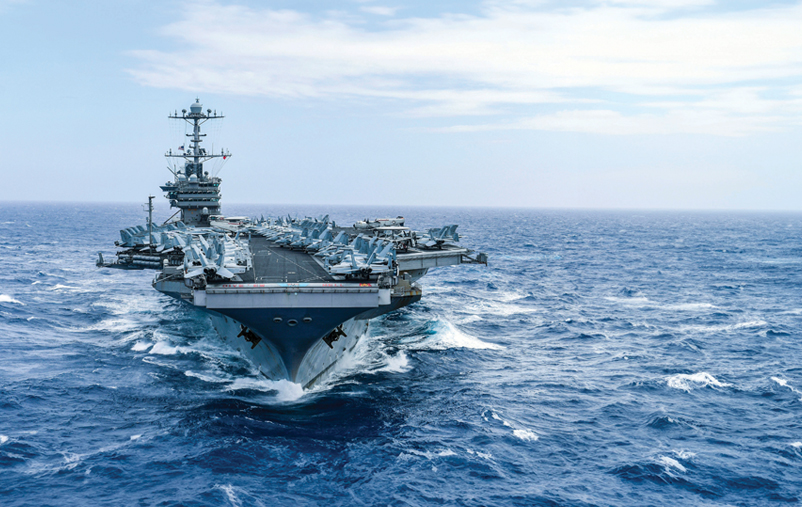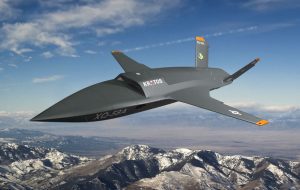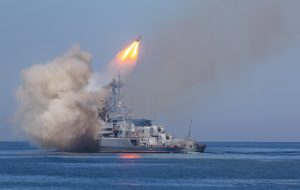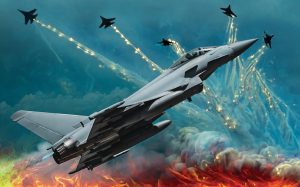Throughout history, control over the sea or maritime mobility has been the primary concern for nations and peoples. To secure this control, naval warfare vessels have been constructed, with their use being the specified goal of naval warfare strategy. In times of war, this strategy involves attacking or defending against enemy naval forces, while in times of peace, it entails combat readiness, including shipbuilding, naval bases, and training.
The philosopher Francis Bacon once remarked, “He that commands the sea is at great liberty and may take as much or as little of the war as he will.” Similarly, Walter Raleigh, one of the architects of the English victory over the Spanish Armada in 1588, noted, “Whosoever commands the sea commands the trade; whosoever commands the trade of the world commands the riches of the world.”
Reflecting on the importance of naval presence, the third U.S. President Thomas Jefferson stated, “If we desire to continue our trade; we must establish a strong naval force.” Naval forces are tasked with defending coastlines, engaging in combat at sea to protect maritime routes, and attacking enemy ships and shores. Naval forces encompass various vessels, including destroyers, battleships, boats, submarines, and aircraft carriers, collectively forming a fleet. Moreover, naval forces can be organized into multiple fleets.
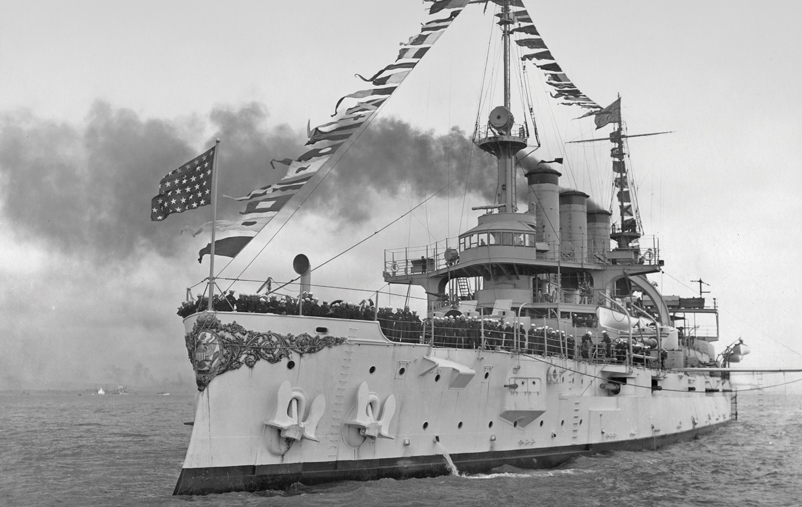
Naval Strategy Throughout History
Naval warfare strategy was recognized in Athens in the 5th century BCE, where the commander Themistocles persuaded his fellow citizens to build a fleet of two hundred ships, asserting that this would make them the strongest nation in the world.
Three years later, when the mighty Persian army advanced with a naval fleet providing logistical support towards Athens, there was little chance of defeating them in a difficult land battle.
Themistocles organised his ships, annihilating the Persian fleet, forcing the enemy army to retreat and enhancing Athens’ prestige.
The United States remained without a navy for a decade. However, due to attacks on American merchant ships by Barbary pirates, the solution was to establish an armed naval force to protect American merchant ships. The first American warship was launched in 1797.
Despite the good protection provided by these ships for trade, American leaders proposed adding more ships and expanding the navy’s capabilities. Following the war with France, the U.S. Navy devised a grand plan to wage war against Britain and France to expel their forces from American territories in 1812.
The U.S. Navy succeded in expelling numerous ships belonging to the British Royal Navy and forced all British forces to leave Lake Erie and Lake Champlain.
On June 26, 1897, the Royal Navy conducted a review in honour of Queen Victoria’s Diamond Jubilee, representing the largest display of naval vessels witnessed worldwide.
The advancement in steel manufacturing in the 19th century contributed to the rapid expansion of the American Navy and in 1907, an American fleet named the Great White Fleet, was manufactured and circumnavigated the globe in 14 months, by order of President Theodore Roosevelt.
Its mission was to demonstrate the navy’s capability to the world and by 1911, the United States had begun constructing a fleet of naval battleships known as “super-dreadnoughts,” which ultimately became capable of competing with Britain.
Following World War II, the U.S. Navy participated in the Korean War and the Vietnam War, where naval operations were focused on coastal areas, utilizing aircraft carriers to strike the enemy and attempt to control coastal cities and transport weapons, equipment, and helicopters to the Vietnamese interior.
The prospects of armed conflict with the Soviet Union during the Cold War spurred the U.S. Navy to continue its technological advancement by developing new weapon systems, ships, and aircraft.
The American naval strategy shifted to forward deployment in support of U.S. allies, focusing on manufacturing and developing groups of fighter aircraft carriers.
In 2007, the U.S. Marine Corps and Coast Guard joined the U.S. Navy, adopting a new strategy called the Cooperative Maritime Strategy.
Moreover, the U.S. Navy Command enacted a law stipulating that there must be at least 11 aircraft carriers in service at any given time. Aircraft carriers are usually deployed alongside additional ships, forming a carrier strike group supported by cruisers, destroyers, frigates, and submarines, providing defence against air and underwater threats, as well as logistical support through supply ships and ammunition.
Maritime Strategy: Challenges and Evolving Tactics
Compared to the sea, armies move on land in a predictable pattern set by the relatively small theatres of operations constrained by natural routes that connect populated areas. Hence, it’s relatively easy to identify their objectives. On the other hand, discovering enemy naval units in the vastness of the seas is akin to finding a needle in a haystack.
This disparity can weaken maritime warfare defence strategies due to the uncertainty surrounding the location of enemy naval units. On land, the enemy’s advance can be observed, and a specific stance can be taken to effectively deal with the situation.
Moreover, on land, numerical weaknesses can be compensated for by utilising mountain peaks, forests, and villages, a luxury not available at sea. Furthermore, the sea serves as an international transit area where the interests of warring parties and other external entities intersect.
When maritime actions jeopardise the interests of neutral parties, the consequences can be catastrophic, as evidenced by the sinking of the British liner Lusitania and the death of 128 Americans by a German submarine in 1915, leading to the United States’ involvement in confrontation with Germany.
During the 19th century, steam replaced sails, battleships and cruisers supplanted old ships and frigates, and warships and torpedoes replaced galleys and fire ships. In the post-Cold War era, navies relied heavily on aircraft carriers, necessitating entirely new strategies and fleets.
By the early days of World War II, aircraft carriers replaced battleships as the mainstay of naval fleets. Rapid advancements in aviation technology transformed carriers from platforms merely providing reconnaissance aircraft to scouting enemy fleets and adjusting artillery fire to becoming formidable offensive platforms themselves.
Aircraft carriers can now launch strikes hundreds of miles away from their location, compared to warships that can only shell targets a few miles away.
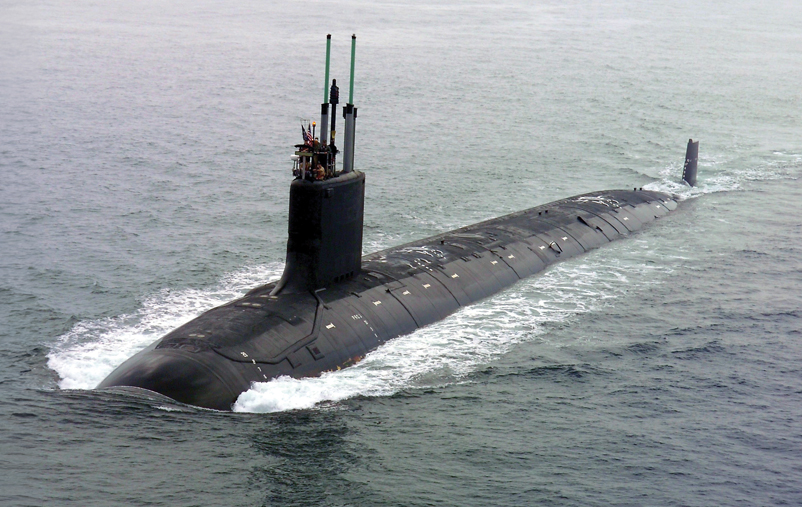
Emerging Threats
Today, advancements in information technology, coupled with the proliferation of advanced military technology, increasingly expose aircraft carriers and their crews, numbering in the thousands, to potential attacks.
To counter this, the US Navy plans to spend billions of dollars on new supercarriers and is currently testing expensive new missile systems to defend its carrier strike groups. The technological advancement that exposes aircraft carriers to risk could pave the way for the resurgence of the battleship, albeit in a more efficient, lethal, and diverse form.
Following the Cold War, an increasing number of potential adversaries of the United States started developing or purchasing military and intelligence capabilities that may soon pose a serious threat to American aircraft carriers. These capabilities include:
Long-range reconnaissance and strike capabilities:
Despite their size, locating aircraft carriers at sea is challenging. In recent years, several countries have gained access to satellite surveillance capabilities and other intelligence-gathering capabilities that allow them to monitor aircraft carriers from space, possibly days before the carrier approaches.
On the other hand, during the Cold War, aircraft carriers were used to maintain control over the high seas, thus keeping maritime passages open. However, with the end of the Cold War, concerns about regional threats such as Iran and North Korea have led the Navy to focus on operations in coastal areas to provide better support for American military operations onshore in the event of an attack.
Furthermore, third-world countries now possess the necessary means and ballistic missiles to strike targets at much greater distances and with greater accuracy than they did just a few years ago. It is unclear whether these countries can transfer targeting information quickly enough to carry out successful strikes against carriers, or whether they will be able to penetrate the missile defenses of the American fleet. However, the threat is serious enough for the Navy to expend significant resources to protect carriers from such attacks.
Anti-Ship Cruise Missiles:
Some armies now possess anti-ship cruise missiles, which can be launched from shores, aircraft, ships, or submarines. Although these missiles are not cheap, they have been effectively and sometimes destructively used in recent years.
During the Falklands War in 1982, Argentine Exocet missiles caused significant damage to the Royal Navy. In 1987, amid the Iran-Iraq War, while escorting Kuwaiti oil tankers in the Persian Gulf, Iraq launched another Exocet missile, causing severe damage to the USS Stark and resulting in the deaths of 37 of its crew.
The commander of the US Navy forces in the region expressed concern that as some countries accumulate an increased stockpile of anti-ship cruise missiles over time, integrating them with their attack submarines, ballistic missiles, and sea mines could significantly complicate the fleet’s mission.
Sea Mines:
Mines have long posed a perplexing challenge to navies, with statistics showing that since 1950, 14 US Navy ships have been seriously damaged in mine-related incidents out of a total of 18. During the Gulf War, the cruiser USS Princeton and the minesweeper USS Leader were damaged due to mines.
After the Gulf War, General Schwarzkopf described the Navy’s mine-sweeping capabilities as “old, slow, ineffective, and unable to perform the mission.”
Today, there are 48 naval forces capable of laying mines. Thirty-nine countries manufacture mines, an increase of nine from 1991. Over 20 countries now export mines. Former Chief of Naval Operations Admiral Jeremy Board emphasized that improving service capabilities in this area is a top priority. However, he admitted that there is no easy way to defend against mines. Once these mines are in the water, the Navy will face a significant problem.
Submarines:
Sales of traditional submarines are expected to double over the next decade, with approximately 50 to 60 submarines to be purchased by about 20 countries. Conducting effective combat operations against submarines in coastal areas, where noise levels are much higher than in the open ocean, may be challenging for the Navy.
Furthermore, by operating close to shore, carriers make the task of submarines easier by reducing their search area. These problems can be somewhat balanced by the difficulties faced by third-world fleets in mastering these complex pieces of military equipment.
Ultimately, the cumulative impact of these threats, rather than any one of them, is likely to significantly erode the carrier’s utility. For example, a single mine explosion may not sink an aircraft carrier, but it could reduce its speed, making it an easier target for missiles.
Additionally, even if the carrier does not hit mines, entering a minefield may force it to reduce speed to avoid mines. By operating close to the shore, with reduced warning times of attack, carrier defences may come under pressure, not due to one type of missile, but due to a variety of them.
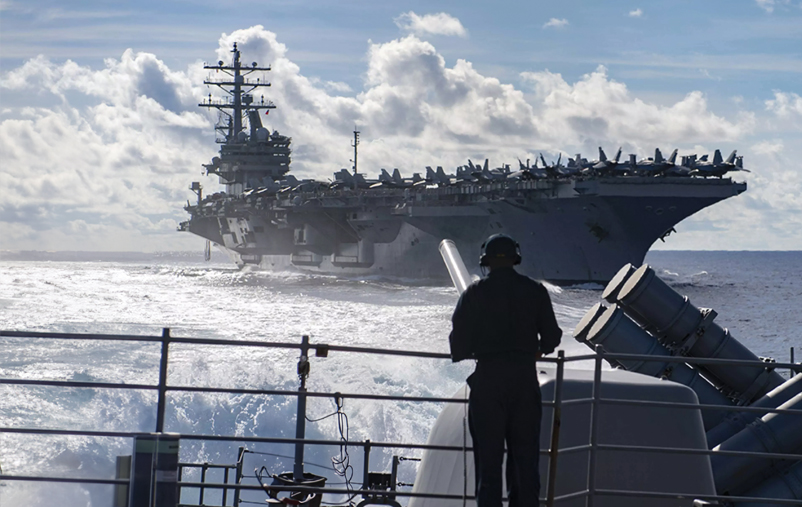
The Navy at a Crossroads
The Navy can chart a familiar course into the future, relying primarily on proven capabilities that have proved their worth over the past half-century. Alternatively, it can somewhat reduce its reliance on traditional forces while quickly harnessing emerging technologies to create an entirely different fleet to face what may be entirely different future challenges.
In short, if the Navy wants to leap into a smaller yet entirely different fleet future, it is likely to find itself embracing a familiar symbol of its past, the warship. Will the US Navy swiftly leverage emerging technologies to build this entirely different, perhaps more efficient fleet, or will it use these technologies to enhance current capabilities? So far the answer remains unclear.
Advancements in missile and precision guidance technology, along with reconnaissance and long-range targeting technology, give ships the ability to surpass carrier-based aircraft in conducting attack operations.
Moreover, navies concerned about limited budgets are likely to purchase and operate such ships at a much lower cost than aircraft carriers, with far fewer sailors at risk.
Furthermore, the emerging offensive capabilities of these new “barges” promise to change the strategic role of aircraft carriers.
Just as the computer revolution transformed from a focus on mainframes to a distributed network of central computers and personal computers, so too can the future navy be transformed. While current fleets focus on aircraft carriers as the hub of naval striking power and devote resources to defending them, the fleet of the future can distribute its offensive capabilities among a variety of ships linked in a system’s network, or “system of systems.” The new distributed ship will form a constellation of strike platforms within a network of surveillance, reconnaissance, and battle management systems.
The key node in this system will be the new shape of the warship. The navy already has a name for it: the Arsenal Ship. The concept of the Arsenal Ship dates back to at least the late 1980s.
The Arsenal Ship does not have the imposing appearance of traditional battleships or supercarriers. In fact, it looks more like a carrier. The ship will be highly automated with a crew of fewer than 100 personnel.
For enhanced protection, it will be semi-submersible with an extremely low profile, featuring stealth technologies, and will also be equipped with active point defences to protect against missile attacks and a double-hull design, providing good protection against mines or torpedoes.
The long surface of the Arsenal Ship will include a network of vertical launch systems, or missile tubes, capable of launching a wide range of long-range precision munitions such as Tomahawk or cruise missiles. The tubes can also launch anti-ballistic missile missiles and remote-controlled drones that collect and transmit data.
»By:Retired Colonel Eng. Khaled Al-Ananzah
(Advisor and Trainer in Environmental and Occupational Safety)


